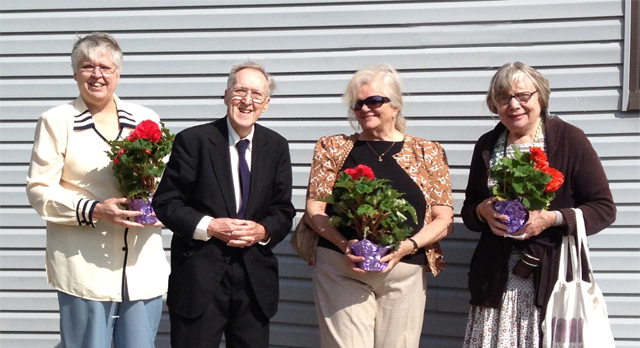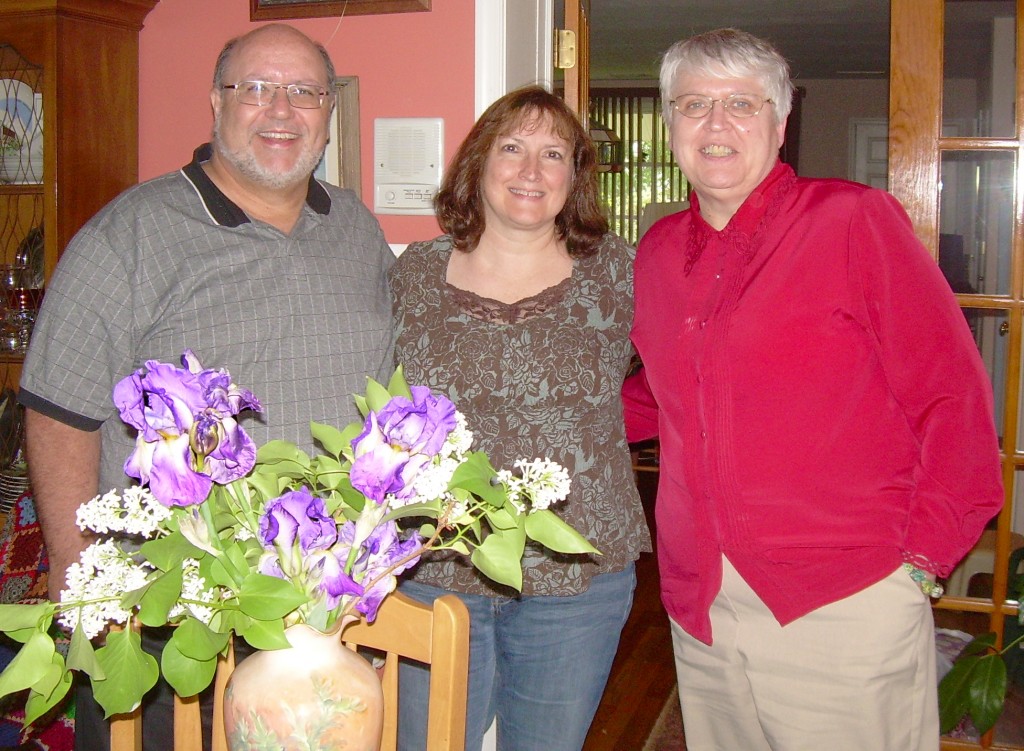My mother died in 2008. Her memory lives. Here are some of the words I spoke at her funeral.
Eulogy for Mom, A Preacher’s Wife
Let me tell you about my mom, Norma Louise Burkholder Gotwald.
Although as a preacher’s wife Mom was known to hundreds perhaps even more, I’m not sure how many people actually knew her. Things may be changing, but in Mom’s time there was a barrier around the preacher’s wife. It’s a barrier of respect and so it was not all bad, but it also was a barrier that for Mom created frustration, a sense that she was not appreciated. She wasn’t accepted as clergy yet she didn’t fit in with the lay members. It was a lonely place to be. Mom was known to many but befriended by few.
These days there is a term for what my mom faced in her adult life. It’s called the glass ceiling. Expectations were placed before her and she was conscientious and dutiful about meeting those expectations, but the personal rewards that most of us seek and expect to gain through our life’s work were not available to her. She was always around people who were following her dream and many of them became her good friends. The area pastors who met at our breakfast table for ministerium meetings valued her input and opinions. She considered them friends. But attaining the status, prestige and full ability to serve in her own right was always within sight but out of reach.
Dad was for most of his professional life a faithful parish pastor. Mom was his wife.
Although it was not discussed, I suspect that if Mom had been born 30 years later, after women were finally recognized by the world as having God-given skills capable of Christian ministry, that Mom would have been the first to enroll at Gettysburg Seminary.
Mom was a biblical scholar. She wore out Bibles preparing Sunday School lessons. She devoted an entire day, week in and week out, for decades to lesson preparation. We can remember many weeks when she fretted that the lesson wasn’t coming together the way she hoped and she wondered if it would be understood and received well by her classes. She had a biblical education that rivaled theologians.
Her granddaughter, Katie, commented that once she had a Bible question which she intended to take to her grandfather, the preacher. Her mother, Sarah, said, “Ask Nomie. She’ll know the answer.”
Mom was a stay at home Mom — a stay at home Mom with a full-time volunteer job of preacher’s wife.
She ran the household and raised a family of which I am proud to be part. Her children grew to adulthood without straying and all have fine families of their own and meaningful careers. We remain close.
All of the grandchildren are friends despite some distance. In her later years, Mom longed for the family closeness of her childhood days when all the cousins, aunts and uncles would gather at Grandma Ebersole’s house on Sunday afternoon. Extended family relations are difficult for preacher’s families.
Most family holidays center around church. Holidays are the hardest work days of the year for pastor’s families.
The concept of holidays as consisting of worship preceded or followed by a family feast was something I had to learn as an adult. In our family, Easter and Christmas services were so stressful that our family went home, crashed in the living room, and helped ourselves to bologna sandwiches. Keeping up with extended family was all the more difficult for us since most of my uncles on both sides of the family were also ministers. Sundays at Grandma’s was another dream that was out of reach.
Mom was ahead of her time in a way that perhaps can be symbolized by “the hat.” Fifty years ago, women in church were expected to wear hats. Mom hated hats. As a young girl, I knew well that Mom had one hat. It was kept in a dusty round box on the highest shelf of the most remote closet in the house. (Where some parents might hide a firearm.) I remember the fuss that accompanied the occasion when the hat would have to be brought down. It was not a pretty sight.
Mom was courageous. I will always remember grocery shopping with her as a girl. Mom always shopped on Thursday, so it was probably a hot summer day that I accompanied her to the Weiss Food Market. Meat workers were picketing the front of the store, actively discouraging shoppers from buying meat. I don’t remember whether or not Mom bought meat that day. But it wouldn’t be like her to change her plans because of a strike. The checkout people were placing meat purchases deep in the grocery bags so as not to be easily seen by the angry strikers. When we came out of the store, a burly meat worker approached my mom and started rummaging through her cart full of grocery bags. That husky fellow had met his match. I saw my mother’s full powers unleashed for the first time. I was ten years old and I was in awe.
Mom was a detail person. Perhaps this was God’s way of ensuring some sanity and balance in our family.
Anything that she undertook she did thoroughly and exactingly. Her handwriting was perfect and beautiful. Her sewing and craft work were precise.
There is a passage in the Diary of Anne Frank, which always reminds me of Mom. Anne writes about her father, the capable professional man, forced to huddle in hiding in a Dutch attic. She describes him peeling a potato with great care, precision and love. That was my Mom. Would she rather be doing something else? Undoubtedly! But what she found herself doing would be done with perfection.
When Mom peeled a potato it was a work of art. I can’t recall her ever complaining about cooking, but when the last of her children left home, she abandoned cooking suddenly and completely. She had cooked dinner every day for 30 years, she told us, and she hated every minute. She wasn’t doing it any more, she declared. Characteristically, she kept her word. For years, the words “Mom’s kitchen” in our family meant The Jolly Roger Restaurant.
Mom was an idealist. She was excited when she was elected to the board of Gettysburg College. She envisioned helping to shape the educational experience of a new generation. She was frustrated when she found that board meetings were mostly about real estate holdings and endowment funds and became particularly disillusioned when several meetings were spent discussing programs to teach students responsible consumption of alcohol. “I feel absolutely no obligation to teach young people to drink,” she told the board and she did not run for reelection.
Mom was a church teacher. She loved her students and there had to be hundreds of them, having served four congregations for forty years, teaching children’s Sunday School, midweek schools, adult Sunday School and running two-week Bible Schools in the summer. Mom had a remarkable memory for her students and to her last days if you asked about a child she had taught 50 years ago, she could tell you about him or her, share a story or two, recount who the family members were, who else was in the class and often the path that child had pursued. Later in life she taught the seniors at St. David’s and gave them the same carefully prepared instruction she had once devoted to the parish children. She participated in Women’s Groups, but was less enthusiastic about this as she got older. Focusing on church work by gender irked her. Even so, she wrote several programs for use by women’s groups which were broadly used. She also wrote for the Lutheran children’s devotional, The Home Altar. Mom took teaching seriously. Rest assured, if Mom taught you in Sunday School, you were noticed, loved and remembered.
Mom was a musician. She loved music, especially choral music and instilled in all of her children an appreciation for music in general and sacred music in particular.
Mom was remarkable in pursuing her education in an era where many girls did not advance academically beyond high school. This was all the more extraordinary as it was a personal quest of a girl whose father died suddenly when she was 12 (almost exactly 69 years ago — two weeks before Christmas) and whose mother, ill with cancer, died when she was 17. Newly orphaned she became the first in her family to pursue a college degree. She wrote to Gettysburg College, filled out an application and left her Hummelstown home for good. She paid her own way, working a campus job and getting summer employment at the Hershey chocolate factory and later as an aide in the Harrisburg capital building. She borrowed some money from various aunts and uncles, kept a careful record and repaid them all. She studied history and prepared to be a school teacher. Her proudest college achievement was her involvement in the renowned Gettysburg Choir. She cherished the memories of singing under Professor Parker Wagnild and was proud to introduce all of us to him as we were growing up. She learned a great deal from him and used it in her own unsung musical ministry. She sang in choirs, taught children’s choirs, youth choirs and was particularly happy when St. David’s hired her as choir director. This did not come about easily. It was a difficult decision for the church. The church had to wrestle with a new concept.
This job had long been a paid position. But this was the preacher’s wife applying for a paid job and you don’t pay preachers’ wives. Finally, and Mom remembered, Clarence Moore was among those who spoke on her behalf. “I think if Mrs. Gotwald wants this job, she should have it,” he said.
For the first time in decades of church service Mom received a modest pay check. She threw herself into this work and spent countless hours researching music for the enrichment of the parish. I would call and invite her to things in Philadelphia. “I can’t” was the usual response. In the middle of the week, she had choir practice. On the weekends, she had church. When she managed to visit me in Philadelphia she headed straight to Fortress Press where she combed the stacks of anthems. She loved this job. It was her dream job, but sadly this was to be her undoing.
After she served a few years as choir director, Dad left the parish ministry to serve in the bishop’s office.
Shortly after all the farewell festivities for Dad had ended, St. David’s Church Council sent Mom a letter firing her . The reason — Dad was no longer the pastor.
Mom never recovered from this. It was a source of bitterness the rest of her life. Our mother who had always been a giving, outward-looking person began looking increasingly inward.
She was hurt, angry and a depression set in which only the grandchildren seemed to be able to break through. A few members of the parish spoke up in her behalf and she deeply appreciated their efforts. On the surface that job may have seemed like a little insignificant part-time job, but to Mom it was her first and only validation as a professional church worker. When it ended the way it did, it confirmed what she had always sensed — that she was valued only as her husband’s wife. Without her husband she was completely expendable.
These last years have been difficult for both our parents. Mom’s declining health was evident to all of us. Dad was absolutely devoted to her and we take this occasion to thank him for his care and for the model of patience and love he has shown to the rest of us. Pastor and Mrs. Gotwald, Norma and Luther, Mom and Dad, Nomie and Pop, were a team. Together they headed our family. Together they served churches in Northumberland, Emigsville and Davidsville. Together they had a faithful and effective ministry. On this day, we want to remember Mom’s part of this yoked ministry.
I am glad that today we live in a world where talented women with gifts of the spirit are given more opportunity and recognition. I wish my Mom could have grown up in such a world. As it is, she lived a valued life. Perhaps her sacrifices helped pave the way for today’s young women. I know that Mom’s life had an impact on the lives of many others. She was a faithful servant. She was doer of the Word, a sower of the Seed. She was a good and faithful servant. Mom, well done.





